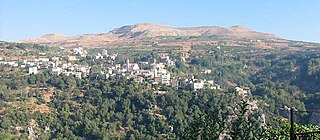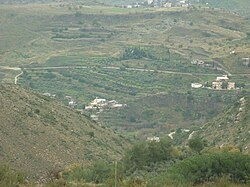
Maron, also called Maroun or Maro, was a 4th-century Syrian Syriac Christian hermit monk in the Taurus Mountains whose followers, after his death, founded a religious Christian movement that became known as the Syriac Maronite Church, in full communion with the Holy See and the Catholic Church. The religious community which grew from this movement are the modern Maronites.

Kadisha Valley, also romanized as the Qadisha Valley and also known as the Kadisha Gorge or Wadi Kadisha, is a gorge that lies within the Bsharri and Zgharta Districts of the North Governorate of Lebanon. The valley was carved by the Kadisha River, also known as the Nahr Abu Ali when it reaches Tripoli. Kadisha means "Holy" in Aramaic, and the valley is sometimes called the Holy Valley. It has sheltered Christian monastic communities for many centuries. The valley is located at the foot of Mount al-Makmal in northern Lebanon.

ʿAin Ebel, the ancient 'En Bol, is a village located in the Lebanese Upper Galilee in the Caza of Bint Jbeil in the Nabatiye Governorate in Lebanon.

The Lebanese people are the people inhabiting or originating from Lebanon. The term may also include those who had inhabited Mount Lebanon and the Anti-Lebanon mountains prior to the creation of the modern Lebanese state. The major religious groups among the Lebanese people within Lebanon are Shia Muslims (27%), Sunni Muslims (27%), Maronite Christians (21%), Greek Orthodox Christians (8%), Melkite Christians (5%), Druze (5.2%), Protestant Christians (1%). The largest contingent of Lebanese, however, comprise a diaspora in North America, South America, Europe, Australia and Africa, which is predominantly Maronite Christian.
Roumieh is a village north-east of Beirut in Lebanon. Surrounded by pine-forested hills, Roumieh is a 10- or 15-minute drive from the coast. Roumieh is known as a pleasant, picturesque small mountain town with many gardens.
Arbet Kozhaya, also known as Arbet Qozhaya or Arabet Kozhaya, is one of the fifty-six towns and villages, which make up the Zgharta District in the North Governorate of Lebanon.
Sawiri or SAWAIRY or es-SAWAIRI (الصويري) is a town (village) in the eastern part of Lebanon.
Miziara is a town located in the Zgharta District in the North Governorate of Lebanon. The village is home to Our Lady of Miziara, Mother of Mercies, St Elias Shrines And to Hotel Miziara the village's first hotel.
Bdadoun, is a town in Mount Lebanon which makes up one of the 70 towns and villages in the Lebanese district of Aley. It has an estimated population of 3,000. It is 499 meters above sea level and 15 kilometres from the capital Beirut. It is known as a summer holiday location.
Deir El Ahmar is a Lebanese town, located 100 km from Beirut and 22 km northwest of Baalbek in the Bekaa Valley in Lebanon.

Bikfaya is a town in the Matn District region of Mount Lebanon. Its stone houses with red-tiled roofs resting amidst pine and oak forests make Bikfaya one of the most sought-after suburbs of Beirut and one of Lebanon's most popular summer resorts. An old town among its monuments is the church of Mar Abda, built in 1587.

Saint Awtel was a monk of the 1st centuries of Christianity venerated in the Middle East. He is celebrated on 3 November, and on 9 October. A church is dedicated to him in the village of Kfarsghab in North-Lebanon where his feast day is celebrated on 3 June and 27 August.

In Ehden, Lebanon, Mar Sarkis is a monastery of the Antonins. It is located in the Zgharta District of the North Governorate, in the Qozhaya valley. It overlooks Ehden, Kfarsghab, Bane and Hadath El Jebbeh. Given its exceptional location commanding the valley at 1500 meters altitude, the monastery is called the Watchful Eye of Qadisha.
Aitou is a village located in the Zgharta District in the North Governorate of Lebanon. Its population is Maronite Catholic.

Kfarsghab in Zgharta District in the Mount Lebanon Governorate of Lebanon predates Christianity. However, like most villages in the Qadisha valley, Kfarsghab's history began with the settlement of the Maronites in Mount Lebanon during the 10th century. According to the popular tradition, the church of Saint Awtel was built on the ruins of a pagan temple. Pagan temples existed in this region as attested in the Greek inscription mentioning the date 272 AD found in the Mar Mama church in Ehden. Other temples may have existed in the region, such as the monastery of Mar Sarkis and Bakhos in Ehden, which may have been built atop ruins. Given the exceptional location of Saint Awtel's Church built on a promontory, the popular tradition about the existence of a pagan temple in Kfarsghab is plausible.
El Mansourieh is a village in the Matn District of the Mount Lebanon Governorate, Lebanon. It is historically important because of the archaeological remains of a Roman aqueduct.

Bdebbaبدبا is a village in Koura District of Lebanon. It has a Maronite and Greek Orthodox population.
Hanna Yussuf Atik is a Lebanese politician, and veteran of the Lebanese Civil War.

The Syro-Lebanese of Egypt, also known as Levantine-Egyptians or Syro-Egyptians, are an ethnic minority group in Egypt. They are Egyptians who have ancestry originating from the Levant, mostly what is now Syria and Lebanon. The majority of Egypt's historic Syro-Lebanese community is Christian, mainly Eastern Catholic and Eastern Orthodox.
Kfarmishki, also spelled Kfar Mishki or Kfar Mechki, is a small mountain authority in the Rashaya District of the Beqaa Governate in Lebanon. This village is located approximately 92 km southeast of Beirut and lies at an altitude of 950–1350 m above sea level on the western slope of Mount Hermon within the Anti-Lebanon mountain range.
















